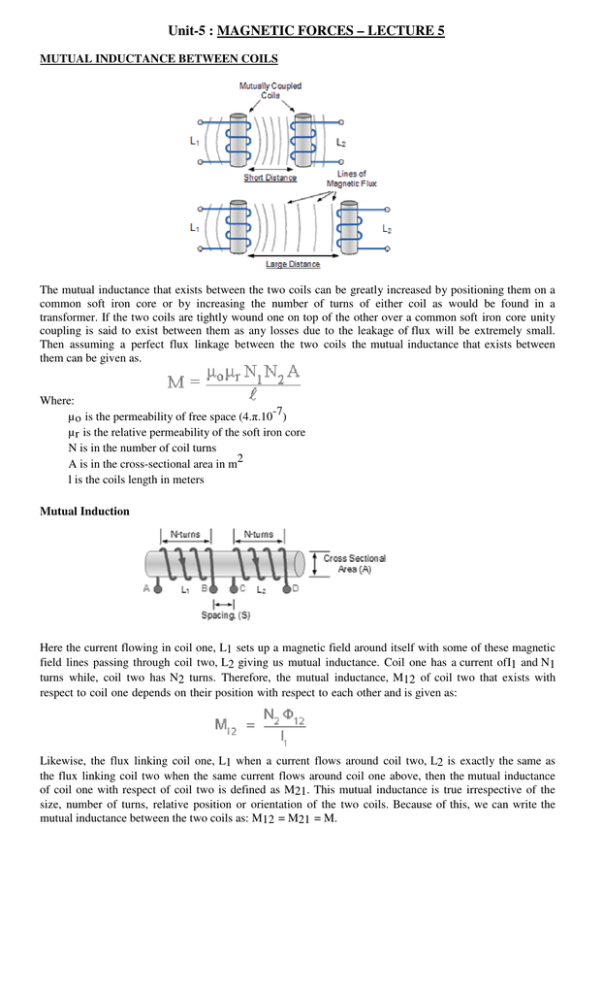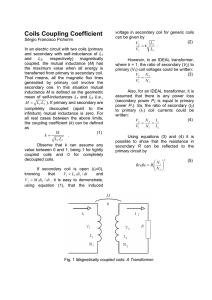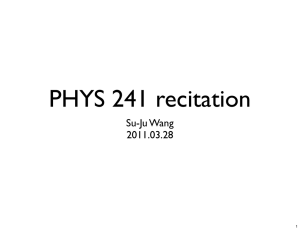Document
advertisement

Unit-5 : MAGNETIC FORCES – LECTURE 5 MUTUAL INDUCTANCE BETWEEN COILS The mutual inductance that exists between the two coils can be greatly increased by positioning them on a common soft iron core or by increasing the number of turns of either coil as would be found in a transformer. If the two coils are tightly wound one on top of the other over a common soft iron core unity coupling is said to exist between them as any losses due to the leakage of flux will be extremely small. Then assuming a perfect flux linkage between the two coils the mutual inductance that exists between them can be given as. Where: µ o is the permeability of free space (4.π.10-7) µ r is the relative permeability of the soft iron core N is in the number of coil turns A is in the cross-sectional area in m2 l is the coils length in meters Mutual Induction Here the current flowing in coil one, L1 sets up a magnetic field around itself with some of these magnetic field lines passing through coil two, L2 giving us mutual inductance. Coil one has a current ofI1 and N1 turns while, coil two has N2 turns. Therefore, the mutual inductance, M12 of coil two that exists with respect to coil one depends on their position with respect to each other and is given as: Likewise, the flux linking coil one, L1 when a current flows around coil two, L2 is exactly the same as the flux linking coil two when the same current flows around coil one above, then the mutual inductance of coil one with respect of coil two is defined as M21. This mutual inductance is true irrespective of the size, number of turns, relative position or orientation of the two coils. Because of this, we can write the mutual inductance between the two coils as: M12 = M21 = M. Hopefully we remember from our tutorials on Electromagnets that the self inductance of each individual coil is given as: & Then by cross-multiplying the two equations above, the mutual inductance that exists between the two coils can be expressed in terms of the self inductance of each coil. giving us a final and more common expression for the mutual inductance between two coils as: Mutual Inductance Between Coils However, the above equation assumes zero flux leakage and 100% magnetic coupling between the two coils, L 1 and L 2. In reality there will always be some loss due to leakage and position, so the magnetic coupling between the two coils can never reach or exceed 100%, but can become very close to this value in some special inductive coils. If some of the total magnetic flux links with the two coils, this amount of flux linkage can be defined as a fraction of the total possible flux linkage between the coils. This fractional value is called the coefficient of coupling and is given the letter k. Coupling Coefficient Generally, the amount of inductive coupling that exists between the two coils is expressed as a fractional number between 0 and 1 instead of a percentage (%) value, where 0 indicates zero or no inductive coupling, and 1 indicating full or maximum inductive coupling. In other words, if k = 1 the two coils are perfectly coupled, if k > 0.5 the two coils are said to be tightly coupled and if k < 0.5 the two coils are said to be loosely coupled. Then the equation above which assumes a perfect coupling can be modified to take into account this coefficient of coupling, k and is given as: Coupling Factor Between Coils When the coefficient of coupling, k is equal to 1, (unity) such that all the lines of flux of one coil cuts all of the turns of the other, the mutual inductance is equal to the geometric mean of the two individual inductances of the coils. So when the two inductances are equal and L 1 is equal to L 2, the mutual inductance that exists between the two coils can be defined as:



